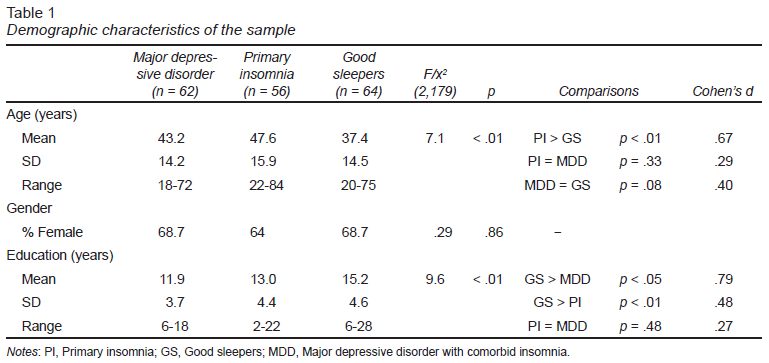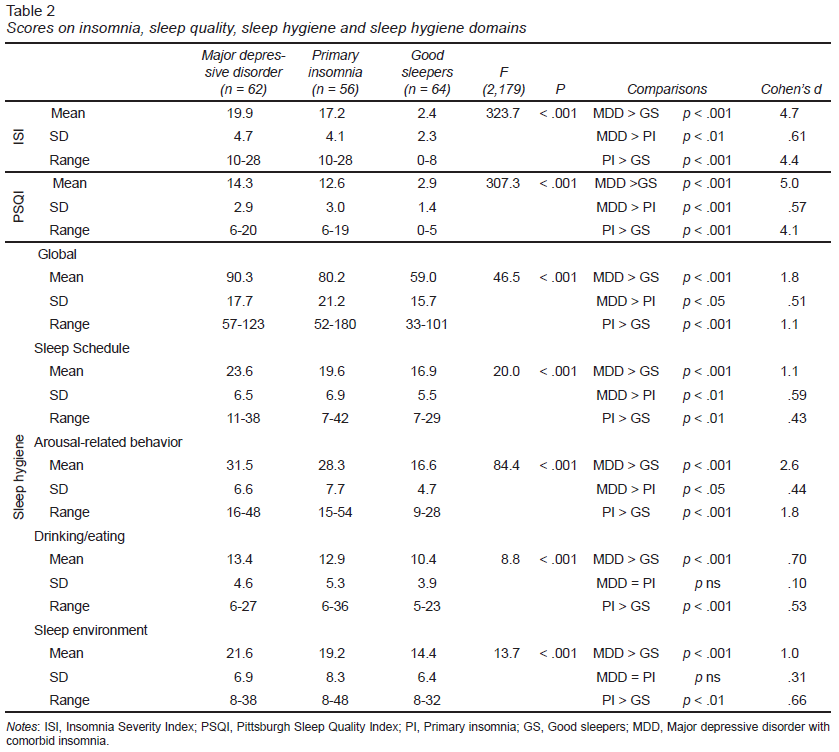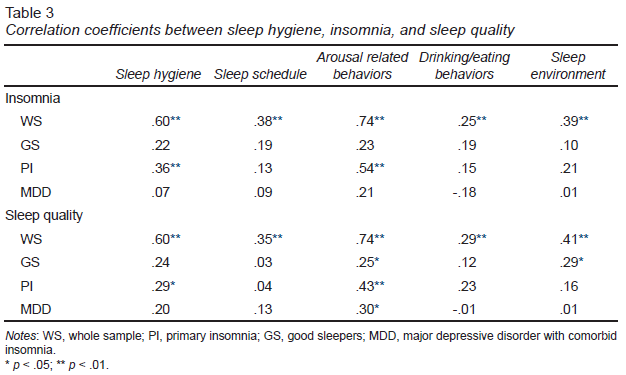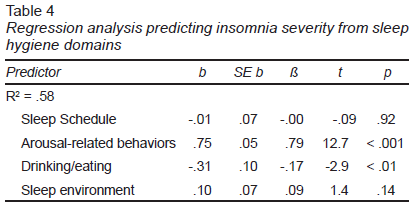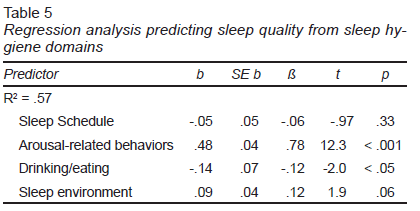Introduction
Inadequate sleep hygiene has been considered one of the several factors contributing to poor sleep and insomnia, including insomnia comorbid with mental disorders (Nowell et al., 1997; Kohn & Espie, 2005). Sleep hygiene (SH) consists of recommendations aimed at avoiding behavioral practices that interfere with sleep and practicing behaviors that promote good sleep (Stepanski & Wyatt, 2003). However, the study of the association of SH with the sleep of patients with insomnia has yielded mixed results. Whereas Lacks and Rotert (1986) found that insomniacs adhere less to SH rules than controls, Harvey (2000) found no differences in the practice of SH rules between insomniacs and control individuals. In a study of SH practices in a population-based sample of insomniacs, Jefferson et al. (2005) found that subjects with insomnia were more likely to show inadequate SH practices such as smoking, drinking alcohol, napping, and sleeping on weekends in comparison with good sleepers matched by age and sex. In a similar manner, single SH practices (variable sleep length, noise disturbance, going to bed thirsty, and worrying about the ability to fall asleep at bedtime) have been found to predict sleep quality in college students (Brown, Buboltz, & Soper, 2002). Gellis, Park, Stotsky, and Taylor (2014) reported that inconsistent sleep schedules and behaviors that promote arousal near bedtime were significantly associated to insomnia severity in college students. These last findings suggest that some SH components might have a greater influence on sleep than others.
Nevertheless, few studies have assessed the efficacy of SH as a single treatment for insofigurmnia and their results have not been encouraging. In two studies, SH did not produce significant changes in sleep (Friedman et al., 2000; Engle-Friedman, Bootzin, Hazlewood, & Tsao, 1992), and only in one study, SH produced a significant improvement of insomnia (Schoicket, Bertelson, & Lacks, 1988).
The practice of SH in insomnia associated to mental disorders has been scarcely studied (Kohn & Espie, 2005) and as far as we know, the practice of SH by depressed patients with comorbid insomnia has not been explored. The study of this population is particularly interesting if we consider, as has been suggested by Stepanski and Wyatt (2003), that inadequate SH may be operating when there is a greater predisposition to sleep problems as happens with major depression; and maybe only some SH rules may be contributing to patients´ poor sleep.
In this way, in this study we aimed to compare the practice of SH rules between patients with major depression with comorbid insomnia, primary insomnia, and good sleepers; and to examine the relationship between the practice of SH, sleep quality, and insomnia severity.
Method
Subjects
Patients were recruited among the population who sought ambulatory psychiatric attention in the National Institute of Psychiatry Ramón de la Fuente Muñiz (Instituto Nacional de Psiquiatría Ramón de la Fuente Muñiz, INPRFM) in Mexico City between June and November 2013 and between June and October 2016. To be included in the study patients were required to meet the following criteria: (a) age 18 years or older, (b) a diagnosis of major depressive disorder or primary insomnia, according to the Diagnostic and Statistical Manual of Mental Disorders – Fourth Edition criteria (DSM-IV; American Psychiatric Association, 1994), (c) an absence of any comorbid psychiatric disorder, including psychotic or substance related disorders, (d) not being under pharmacologic and/or non-pharmacologic treatment in the previous month, (e) a score > 5 in the Pittsburgh Sleep Quality Index (PSQI; Buysse, Reynolds, Monk, Berman & Kupfer, 1989), (f) a score ≥ 10 in the Insomnia Severity Index (Morin, Belleville, Bélanger, & Ivers, 2011), and (g) signed written informed consent. Control subjects were recruited through advertisements in the same institution and by word of mouth. They were included if they were 18 years or older, had no past or current psychiatric disorder, stated to sleep well, had a PSQI score of five or lower and provided with written informed consent.
Procedure
All subjects underwent the MINI International Neuropsychiatric Interview (MINI; Sheehan et al., 1998) in order to establish the diagnosis based on DSM-IV criteria. Primary insomnia diagnosis was assessed through a semi structured interview based on DSM-IV criteria. In addition, participants answered the following instruments:
The Pittsburgh Sleep Quality Index (PSQI). The PSQI is a self-rating questionnaire developed by Buysse et al. (1989) to assess sleep quality. It consists of 19 items which, grouped into seven hypothetical components (subjective sleep quality, sleep latency, sleep duration, habitual sleep efficiency, sleep disturbances, use of sleep medication, and daytime dysfunction), provide a global score of subjective sleep quality, ranging from 0 (no sleep problem) to 21 (severe sleep problems). A high degree of internal consistency (Cronbach’s alpha = .83) and a cut-off score of six or higher for distinguishing between good and poor sleepers have been reported. The instrument has been widely used in sleep studies and it has been translated into Spanish with acceptable reliability (Royuela Rico & Macias Fernández, 1997). The internal consistency coefficient of the PSQI in our sample was .86.
The Insomnia Severity Index (ISI). The ISI is a widely used self-rating scale designed to measure insomnia (Bastien, Vallières, & Morin, 2001). It contains seven questions that assess insomnia symptoms, sleep satisfaction, interference with daily functioning, impact on quality of life, and concerns about the sleep problem. Total score ranges from 0 to 28, with higher scores indicating more severe insomnia. Its internal consistency is high (Cronbach’s alpha = .90) and a cut-off score of 10 distinguishes insomnia cases. We obtained a high internal consistency (Cronbach’s alpha = .94) with the Spanish version we used.
The Sleep Hygiene Practice Scale (SHPS). This self-report instrument consists of 30 questions about daily behaviors and sleep habits that may affect sleep (Yang, Lin, Hsu, & Cheng, 2010). The items are answered on a six-point Likert scale, from never to always; the sum of scores on all items provides a global measure of sleep hygiene practice. In addition, scores for four sleep hygiene domains can be obtained: sleep schedule and timing (e. g., bedtime not consistent daily, stay in bed after waking up in the morning), arousal-related behaviors (e. g., worry about not being able to fall asleep in bed, checking the time in the middle of the night), poor eating/drinking habits prior to sleep (e. g., going to bed hungry, drinking caffeinated drinks), and poor sleep environment (e. g., sleep environment is either too noisy or too quiet, feeling too hot or too cold during sleep). A higher score indicates more maladaptive SH practices. Yang et al. (2010) reported Cronbach’s alpha coefficients from .58 to .82 for the different domains. In this study, Cronbach’s alpha for the 30-item Spanish version of the scale was .87, while on the subscales were .70 in sleep schedule and timing, .78 in arousal related behaviors, .61 in eating/drinking habits, and .76 in sleep environment.
Statistical analysis
We performed a one-way ANOVA to compare age and schooling years among groups; Bonferroni post-hoc test was used to identify significant differences. For gender comparison chi square was computed. Because of the significant differences found in age and schooling between groups, for subsequent comparisons in ISI, PSQI, and SHPS scores, we used a general linear model, beginning with a model with interaction term (age by group and education by group) to test the homogeneity of covariates (age and education). If the interaction was not significant, we proceeded with an analysis of covariance; otherwise, we would use the model with interaction term. Bonferroni adjustment for multiple comparisons was used to identify significant differences. To assess the relationship between the practice of sleep hygiene with insomnia severity and sleep quality, first, we calculated the Pearson correlation coefficients, and then we performed two linear regression analyses, with insomnia and sleep quality as dependent variables and sleep hygiene domains as predictors. All analyses were conducted using IBM SPSS 21.
Ethical considerations
The research project was approved by the Committees of Ethics and Research from the National Institute of Psychiatry Ramón de la Fuente (Reference No. CEI/C/027/2013). All participants signed a written inform consent and there was no economic compensation for their participation.
Results
One hundred and eighty-two individuals participated in the study: 62 patients with major depressive disorder (MDD), 56 patients with primary insomnia (PI), and 64 good sleepers (GS). While there were no significant gender differences among the groups, patients with PI were significantly older than GS, who, in turn, had significantly more schooling years than PI and MDD patients (Table 1).
Individuals with MDD had significantly higher scores on ISI and PSQI than PI patients, who, in turn, showed significantly worse scores than GS (Table 2). Age and schooling did not contribute significantly to the difference in ISI (age F(2) = 1.7, p = .17; schooling F(2) = 1.9, p = .14) and PSQI scores (age F(2) = .53, p = .58; schooling F(2) = .45, p = .63). Likewise, patients with MDD had the worst practice of SH measured as a whole; again, age and education did not contribute to this difference (age F(2) = 1.2, p = .29; schooling F(2) = 1.8, p = .16). When the groups were compared in the domains of SH, participants with MDD showed a significantly worse practice of sleep schedule and arousal related behaviors than PI group, but there were not significant differences in drinking/eating and sleep environment domains. Both, MDD and PI groups had significantly higher scores than GS in all SH domains (Table 2).
In respect to the relationship between SH practice and insomnia, a significant moderate relation between global SH and ISI scores was observed (Table 3). Likewise, all SH domains showed significant positive relations with insomnia. Similar correlation coefficients were observed for the relation between SH, either global or dimensions, and PSQI scores in the whole sample. However, when correlation coefficients were calculated in each group, a different pattern of results was obtained. In GS, there was no significant relation between SH, either global or any dimension, and insomnia severity. In contrast, sleep environment and arousal-related behaviors showed a weak positive relation with sleep quality scores. In the PI group, significant weak correlation coefficients were observed between the practice of SH as a whole and insomnia and sleep quality; only arousal-related behaviors showed a significant moderate relation with insomnia and sleep quality. In the MDD group, there were no significant relations between insomnia and SH; by contrast, arousal-related behaviors showed a significant weak relation to sleep quality.
The results of the linear regression analyses are shown in Tables 4 and 5. More than a half of the variance in insomnia severity was explained by the model (R2 = .58, F (4, 177) = 61.1, p < .001). However, only arousal-related behaviors (ß = .79, p < .001) and drinking/eating habits (ß = -.17, p < .01) significantly contributed to the model. In the second regression analysis, again, 57% of the variance in sleep quality scores was explained by the predictors together (R2 = .57, F (4, 177) = 59.4, p < .001); but only arousal related behaviors (ß = .77, p < .001) and drinking/eating behaviors (ß = -.12, p < .05) were significantly associated with sleep quality.
Discussion and conclusion
Our results suggest that individuals with insomnia have a worse practice of SH in comparison to good sleepers; we also found that, when insomnia is comorbid with major depression, the practice of SH is even worse. Although poor practice of SH showed a moderate relationship with insomnia symptoms and poor sleep quality in the whole sample, only in patients with PI the association remained as significant but weak.
These results are consistent with those of early (Lacks & Rotert, 1986) and recent studies (Yang et al., 2010) that have found insomnia subjects practice less the SH rules than good sleepers; but our results also differ from findings of some other studies (Harvey, 2000). A possible explanation for this disagreement is the variable definition of SH used in the studies. Investigations that have found a significant association between insomnia and poor SH practice (including this one) have used more comprehensive instruments to measure SH. In support of this view are the findings of Gellis and Lichstein (2009) who used a 19-item SH instrument and found that poor sleepers engaged significantly more frequent in poor sleep SH practices than good sleepers.
Sleep hygiene recommendations lists are quite variable. There are numerous lists, with more or less SH rules and there is no consensus about essential practices or a minimal list. For example, the Hauri’s original list (Hauri, 1977) shows some differences from his own updated list (Hauri, 1992) and also from the maladaptive practices included in the Inadequate Sleep Hygiene category of the International Classification of Sleep Disorders 2 (Stepanski & Wyatt, 2003; American Academy of Sleep Medicine, 2005). Moreover, some of the SH recommendations may overlap with the more clearly defined interventions such as stimulus control or sleep restriction therapies.
In this sense, the study of isolated SH practices or SH dimensions may shed light on the active ingredients of SH. We found that patients with insomnia, either primary or comorbid with major depression, had a worse practice in all SH dimensions than good sleepers. However, although good sleepers had a better practice in all SH domains, only the sleep environment domain and arousal related behaviors showed a weak but significant association to sleep quality. Similarly, in MDD patients only arousal-related behaviors had a weak association with sleep quality, even though MDD group had the worst practice of SH rules. This suggest that SH practice has a small contribution to the sleep of GS and MDD individuals. Only in the PI group, the practice of arousal-related behaviors was moderately associated to insomnia and sleep quality.
The arousal-related behaviors dimension of SH was the only one that showed a consistent, significant relationship with sleep quality and, more importantly, it was the main predictor of insomnia severity and poor sleep quality. This finding is consistent with observations of Gellis and Lichstein (2009) who found that poor sleepers presented with more worries, plans or thoughts about important matters in bed than good sleepers; and also, it concurs with results of Yang et al. (2010) who using the SH Practices Scale identified that the practice of maladaptive arousal related behaviors was the only one significant difference between insomnia subjects and good sleepers. The contribution of arousal-related behaviors to insomnia severity is not a surprise; in fact, is consistent with the physiologic, cognitive, and emotional hyperarousal state associated with insomnia which is one of the targets of cognitive behavioral therapy for insomnia (CBT I), including comorbid insomnia with major depression (Manber et al, 2008).
Although we found that the presence of major depression was associated with a worse practice of SH in general and in all SH domains in comparison with good sleepers, the lack of significant relation of SH with insomnia scores suggests that the contribution of SH to insomnia severity in major depression might be negligible.
Even when the evidence about the poorer practice of SH by individuals with insomnia is inconclusive, and some reports have informed about its lack of efficacy as a monotherapy, SH education remains one of the interventions included in multicomponent therapies. This might be due, at least in part, to its popularity and acceptance. Sleep hygiene is probably the most popular behavioral insomnia approach and some studies have found that patients prefer it to other therapies (Vincent & Lionberg, 2001). But it is also possible that SH is not lacking effects on insomnia symptoms. A recent systematic review has shown that although SE is less efficacious than CBT I, treatment with SH is associated with improvement of several sleep indexes (Chung et al, 2017). Considering our results, the correction of arousal related behaviors might be the main mechanism underlying the mild sleep improvement produced by SH. Taken together, the SH’s popularity, its acceptance, and its possible effects on arousal-related behaviors might be enough reasons to maintain SH in multicomponent therapies. To say the least, SH may serve as an entry step or a as an induction intervention to more efficacious therapies. This speculation deserves future research.
On the contrary, if the contribution of inadequate SH to insomnia is just through the practice of maladaptive arousal related behaviors which can be properly treated with other interventions, future investigations should consider the exclusion or substitution of SH in multicomponent therapies.
There are several limitations to this study that should be acknowledged. We did not include a sample of depressed patients without insomnia; consequently, our results cannot be generalized to this infrequent expression of major depression. Although the instrument we used to assess SH showed a satisfactory reliability coefficient, the subscale of eating/drinking behaviors had a slightly low coefficient of internal consistency; therefore, the significant findings associated with this SH domain could be questionable. Nevertheless, our results are in line with reports of a higher use of sleep disrupting substances among poor sleepers (Jefferson et al., 2005; Johnson, Rohers, Roth, & Breslau, 1998). Likewise, although we tried to study the association of a set of behaviors with insomnia, we did not evaluate isolated behaviors or dimensions; therefore, some SH rules/domains might be operating through combined mechanisms. Finally, our results do not inform whether inappropriate SH practice is a predisposing, precipitant, or perpetuating factor, which is of particular relevance in the context of Spielman’s model of insomnia (Spielman, Caruso, & Glovinsky, 1987).
Our results show that patients with insomnia, either primary or comorbid with major depressive disorder, have a worse practice of SH in comparison with good sleepers. However, the contribution of inadequate sleep hygiene to poor sleep seems to be through the practice maladaptive behaviors related with arousal.
